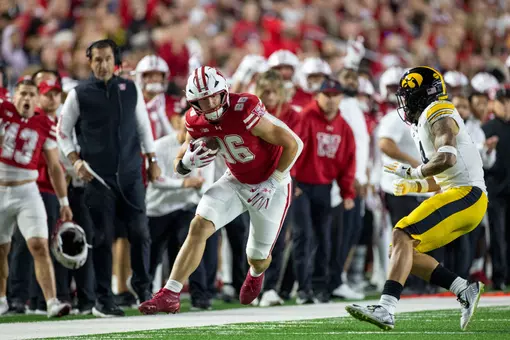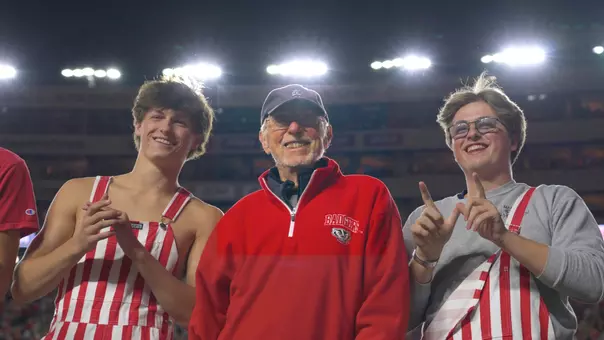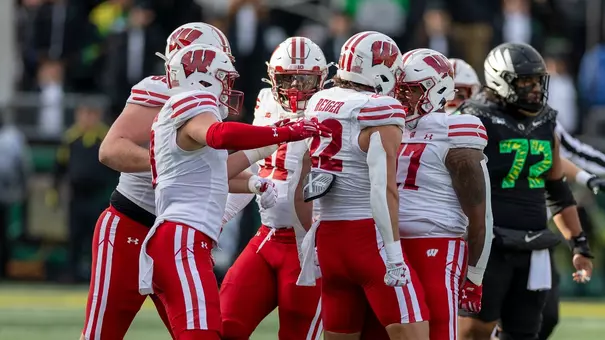Three and Out with Mike Lucas: Purdue
November 07, 2014 | Football

 | ||
|
Nov. 7, 2014
BY MIKE LUCAS
UWBadgers.com
MADISON, Wis. -- Tyler Marz. Dallas Lewallen. Dan Voltz. Kyle Costigan. Rob Havenstein.
They have been called one of the most physically imposing offensive lines in college football.
Imagine the looks when they walk into a restaurant together.
Especially from the kitchen help. Or those entrusted with feeding them.
That nightmare has been playing itself out every Thursday night for about a month. As a group, they’ve been getting something to eat together after practice.
“We’ll go to Buffalo Wild Wings,” said Voltz. “Or just go get a burger.”
What’s the reasoning behind these O-line chow-downs?
“Just to bring us together,” Voltz said. “The game is two days away and we’re all best friends, the five of us, so anytime we can hang out together, it’s just awesome.”
There are no parameters on what is discussed at the table, with one notable exception.
“No football,” Voltz said. “We talk guy stuff; what’s going on in our personal lives.”
No position group may be more dependent on cohesiveness/chemistry than the offensive line.
“It’s very important to have comradery and friendship and trust for everyone across the line,” said Voltz, pointing to the carryover on game days. “It’s essential in situations when you’re on the road.
“At Rutgers, you get stuffed three plays in a row, but you know these guys next to you are going to rally and figure it out because of the trust that you have in everyone that you’re playing with.”
Or eating dinner with. For the record, Voltz says nobody eats like the 6-foot-6, 323-pound Lewallen.
“We call him the human garbage disposal,” he said. “He can chow all day. But he has to keep his figure, so he has to limit it.”
Having what Voltz labeled as “that connection” with his offensive linemates can be invaluable, especially when a defense is getting some stops, like Rutgers did in the first quarter last Saturday.
“More than half the downs they brought some form of pressure, which we knew that they were going to do,” Voltz said. “They did a good job of those pressures and caught us on a few of them.”
But nobody panicked, nobody got impatient.
“When a team pressures like that, it’s feast or famine,” Voltz pointed out. “They’re either going to get a TFL or we’re going to get a big play. That’s just how the game goes.
“They might stuff you on a couple in a row and you just have to stick to the game plan and do what you do and eventually it will pop, and that’s what happened.”
The beneficiaries were Wisconsin tailbacks Melvin Gordon and Corey Clement.
“We had some big explosive plays,” Voltz said.
It’s really all academic for Voltz, one of the brightest guys on the roster with a 3.48 cumulative grade point average in kinesiology. Thursday, he was named to the Capital One Academic All-District team, making him eligible for Academic All-America honors.
On the field, the last two games have been challenging for Voltz because both Maryland and Rutgers tilted their nose guard over the center, forcing Voltz to adjust to the shade technique.
“Playing against a shade in the Big Ten, you’re one-on-one with the shade,” said Voltz, a redshirt sophomore from Barrington, Illinois. “It’s never an easy task because we’re running a lot of zone.
“But that’s Big Ten football. We’re going to run the ball and, when you’re the center, you have to be able to do that (execute the zone blocking scheme).
“It’s man-on-man, one-on-one, who’s going to win? I don’t win every time, but I’m getting better and learning. Purdue plays a shade but not a tight shade (like the Terps and Scarlet Knights).”
The Boilermakers present a different challenge for the offensive line because of their size. Nose guard Ra’Zahn Howard is 6-3, 323 pounds; his backup Ryan Watson is 6-2, 291.
“They have some pretty big dudes up front,” Voltz observed. “Probably the biggest D-linemen and D-ends that we’ve faced all year. It’s what we’re used to seeing in the Big Ten; big, physical guys.
“They’re going to try and stuff us in the gaps and we’ve got to move them. And we’re going to do what we’ve done all year, and that’s run the ball.”
Given the close proximity of the shade nose guard and the center, there’s every opportunity for the players to engage in some form of conversation and smack talk.
“Some defenses say a little more than others,” Voltz said. “I’m a quiet guy. I just play.”
• • • •

Joel Stave knows how easily it is to be stereotyped since he’s generally regarded as the “throwing quarterback” in Wisconsin’s offense, with Tanner McEvoy being the “running quarterback.”
But what happens when the throwing quarterback runs?
At Rutgers, it resulted in a 9-yard gain for Stave. McEvoy’s longest run against the Terrapins was 8 yards.
Stave doesn’t make a habit of running; his longest career rush is 16 yards. And that was two years ago against Nebraska.
But it doesn’t hurt to break a tendency, and that’s what he did last Saturday on a first down run from the UW 48. On the next play, Stave handed off to Corey Clement, who dashed 43 yards for a score.
“Obviously, I’m not known for my running ability,” said Stave, who has five carries in four games this season for a net of minus-21. “But I think it’s something that I can do in the right situations.
“When it’s wide open in front of me and I can pick up a few yards and get out of bounds or slide, or whatever I need to do, it’s something I’m able to do.”
Who scored the first touchdown of the 2013 season for the Badgers? It was Stave on a 4-yard run against UMass in the opener.
Ovrerall, in 13 games, he had 37 carries for a minus-22. His long was 10.
Upon further review of his 9-yard run at Rutgers, he said, “Had I stayed in there a little longer, (wide receiver) Rob Wheelwright came open.
“But when I broke contain and I looked out in front of me, I was shocked at how open it was and I decided pretty early that I better take this when I can.”
After Tuesday’s practice, Stave sounded content sharing some snaps with McEvoy.
“It has continued to grow, it has continued to get better,” he said. “It’s a new thing for all of us and something we’re working through.
“I definitely think there’s room for improvement as there always is. It’s a matter of when you’re not on the field; you have to make sure you’re staying in it mentally.
“And when you are (on the field), you have to make sure you’re making plays that you can make and controlling what you can control.”
When Stave comes to the sideline, he takes a seat and gets on the headset with offensive coordinator Andy Ludwig, who’s calling the game from the press box.
“We review all the plays that were just run,” Stave said, “and what went wrong with them.”
And they also discuss the plays that they would like to run on the next offensive possession.
“But with the way the defense has been playing,” said Stave, “they haven’t been on the field very much, so we don’t have a ton of time on the sidelines between series.”
The defense has been playing so well, the offense feels obligated to reciprocate, Stave acknowledged. It’s the best possible situation to have for a team -- one unit feeding off the other.
“We just have to make sure we’re paying them back with good offensive production and by scoring points,” said Stave, who’s now 16-6 as Wisconsin’s starting quarterback.
“When they’re getting stops, three-and-outs, and getting us the ball back around midfield time and time again, we have to reward them with sustained drives so they can be rested and ready to go.
“Football is the ultimate team game in that respect,” Stave added. “Even though we’re not on the field, what they do (as a defense) affects us so much and what we do affects them so much.”
• • • •

Wisconsin safety Michael Caputo got his first “special teams” tackle of the season at Rutgers.
It’s a role that he relishes.
“They want young guys out there,” he said, “but I try to get on special teams.”
It’s true that most coaching staffs would prefer to spare their starters from extra snaps. But try and tell that to Caputo, the UW’s starting strong safety and leading tackler.
“I love special teams,” he said, “because it’s you versus someone else. It’s the simplest part of the game. All you have to do is do your job -- be the guy and go make a play, whatever it may be.
“It’s the fun part of the game; some people don’t realize that and they blow it off. They don’t think special teams influence a game. And then one play breaks and the momentum shifts.”
When he was younger, Caputo played on all of the UW’s special teams. Specifically, he remembered covering kickoffs in the 2012 Big Ten Championship Game against Nebraska.
It seemed like he was on the field all night -- the Badgers scored 70 points.
“I had the same job every time,” he recalled. “I would come down and fill in this crease and it was basically me versus the returner. That led to my neck injury; hitting guys like that all the time.”
Despite that injury, he doesn’t want the rules-makers tinkering with the game; he doesn’t want kickoffs eliminated. “The game is fine the way it is,” he said. “You have to be smart in making it safer.”
Caputo will be on the punt cover unit Saturday at Purdue.
“I enjoy blocking (for the kick), running down there and tackling someone,” he said.
As it is, the Badgers are now employing two punters: Drew Meyer and Bart Houston.
Both are capable of executing the rugby-style kick, more so Houston. The intrigue with Houston is that he’s the No. 3 quarterback behind Stave and McEvoy. The Badgers have already thrown once out of punt formation; Meyer completed the pass.
“It’s sweet, I like it,” Caputo said of the two-punter system. “It keeps everyone on their toes.”













